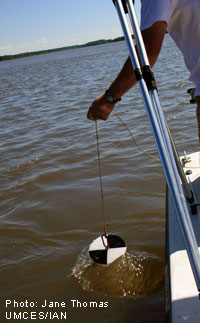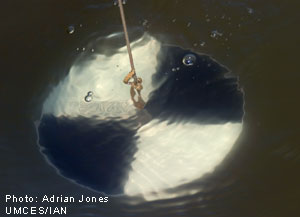Seagrasses need light to produce food through photosynthesis. The light that the seagrasses receive must penetrate the water column in order for it to be efficient. There are many things that can prevent the seagrass from receiving light. Suspended sediments and chemicals are two of the major restrictors.
Objective
This activity will show students the importance of light availability in seagrass health.
Materials
- 3 or 4 very large buckets
- Flour (represents milky waters found in some areas of the world)
- Mud
- Gravel or sand
- Glitter (represents shiny rocks found at the bottom of the water)
- A well lit area (outside is best)
- 4π light meter*
* If you do not have access to a 4π or 2π light meter, you may use a secchi disk, purchased for less than $30 from scientific equipment supplier, such as Science First. If you do not have a secchi disk, you can easily make one. Directions are included below.
Procedure (if light meter is used)
Fill each of the buckets ¾ of the way with water. Place the light meter at the bottom of the first bucket. Record the light reading then take the light meter out. Add the mud to the bucket. Observe the bucket and place light meter in the bottom of the bucket. Record the reading from the meter. Repeat these steps for the next two or three bucket, but add different ingredients to each.
Procedure (if secchi disk is used)
Fill each of the buckets ¾ of the way with water. Lower the secchi disk into the first bucket to show students that you can see to the bottom. Take the secchi disk out. Add the mud to the bucket. Observe the bucket and lower secchi disk into the bucket until you can no longer distinguish the black from the white. Measure how deep the secchi disk was lowered. Record the depth and any other observations. Repeat these steps for the next two or three bucket, but add different ingredients to each.
Discussion
Discuss the results with your class. Ask them what the difference was between the different ingredients that were added. Ask how the different ingredients affected the amount of light at the bottom. Make connections between the ingredients used and the real restrictors in a seagrass habitat.
*How to make a secchi disk
 Secchi disks can be ordered from scientific supply stores and can be found for less than $30. If you choose to make your own, below are some basic instructions.
Secchi disks can be ordered from scientific supply stores and can be found for less than $30. If you choose to make your own, below are some basic instructions.
Obtain a white Frisbee, plastic lid, white plastic plate or laminated white piece of paper (circle). Cut out a circle with a diameter of 20cm. Punch a hole in the center. The color of the secchi disk will be split up into alternating black and white sections (2 white, 2 black, see photograph below). You can use a black permanent marker or black acrylic paint to color in the black portion of the disk. Tie a knot at one end of about 5 ft of rope and place string through the hole. Attach some weights to the bottom of the disk so it easily sinks to the bottom of the bucket. Metal washers work well for this purpose. You may wish to mark the rope every cm for ease of taking measurements. Your new, homemade secchi disk is ready for use!
National Science Education Standards
9-12 A. Science as Inquiry
- Abilities necessary to do scientific inquiry
- Understandings about scientific inquiry
9-12 C. Life Science
- Interdependence of organisms
- Behavior of organisms
9-12 F. Science in Personal and Social Perspectives
- Population growth
- Environmental quality